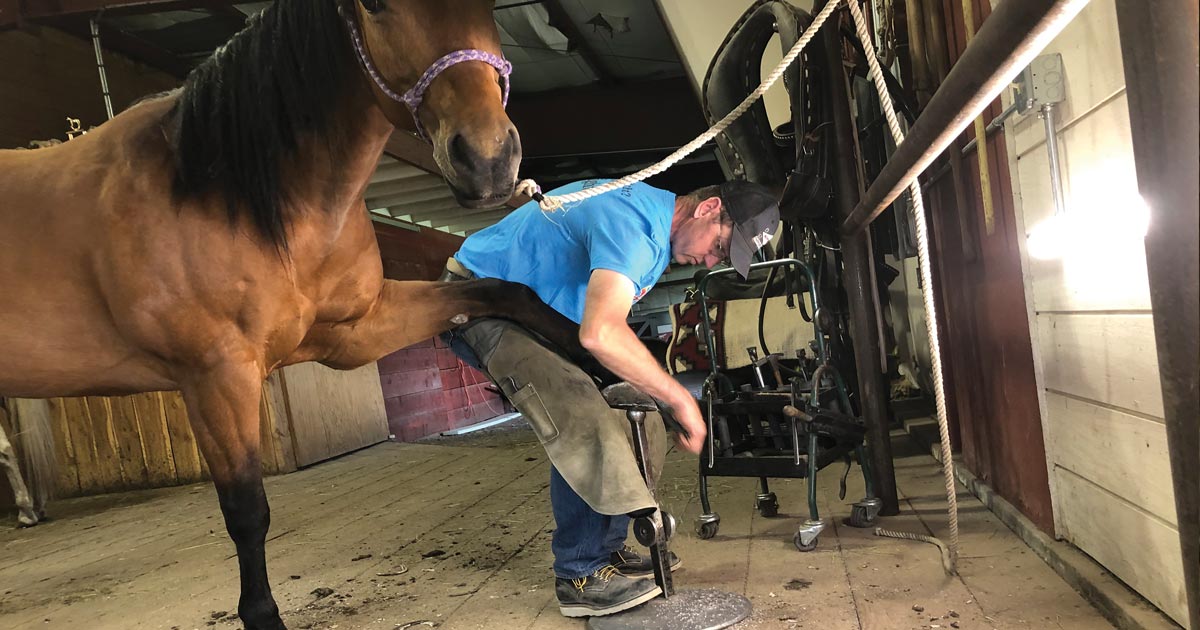I spent a few years in college as a cobbler, mostly repairing high heels and blown out work boots. I learned a lot about leather and the difference between a walking heel and a working heel, but mostly I learned that cobbler shops and shoe repair are mostly things of the past. It’s a craft and skill that has vanished as we’ve become more and more a throwaway society.
But if you own horses, you know that you can’t just go to Murdock’s and buy your animal a new set of shoes every month or so. As long as humans continue to work and play with horses, there will be a demand for farriers, which is what the folks who shoe horses are called.
A farrier is something like a cobbler on steroids: you have to be part veterinarian, part blacksmith, and part animal psychologist.
A cobbler might make you a pair of boots, but he doesn’t have to trim your toenails and then attach the boots to your feet. Being a farrier requires a collection of different skills, some “horse” sense, as it were, and a tolerance for working outdoors in all kinds of weather.
A city of roughly 50,000 people—the size of Helena, Montana, say—probably only has one or two cobblers in the yellow pages, but might have 25 to 30 farriers around.
“There’s at least 30 in this valley,” says retired farrier Bill Davis of Helena. “Of varying skills, of course. Probably only four or five are certified, and you pay accordingly.” Davis himself acquired the skill growing up on a ranch near Fairfield.
“For 20 years I learned as I went, learning from an uncle. If you have a ranch, you have to shoe horses. Then the neighbors started asking me, and before long I had a part-time job being a farrier, and then a full-time job. And then I went to Farrier school in Bozeman and found out I was doing a lot of things wrong and finally learned how to do it right.”
Earl Craig, a farrier in the Shields Valley, went to a shoeing school in Kentucky, and now works full-time shoeing horses from White Sulfur to Bozeman.
“It’s a pretty good living,” he says. “I like working outdoors, and I am constantly learning.” Craig explains a farrier has to know equine anatomy as well as some blacksmithing skill for heating metal shoes and fitting them to a horse’s hooves.
Most Montanans don’t own horses, and they don’t realize how expensive they are to board and pasture. Horses are called “hayburners” for a reason. But keeping them shod is a whole other expense.
“Depending on the horse, and how far I have to travel and so on, it’s around $160 to shoe a horse,” Craig says. “And you have to shoe them every six or eight weeks. It’s an expense, for sure.”
Davis concurs: “A horse worth $50,000 or $100,000 you want to take care of, and proper shoeing is critical.” It takes about an hour to shoe a horse, so a busy farrier can make a decent wage.
In addition to learning how to fire up a blacksmith forge and shape hot metal, you have to understand how horses work and how the angle of the hoof affects gait, for starters.
“A common mistake is an amateur tends to leave the heel too high,” says Davis. “It’s important to balance the foot.”
According to Craig, a farrier has to be part vet, part blacksmith, and part horse trainer. “It’s a satisfying job because you’re constantly learning—it involves a lot of continuing education.”
Why Horses Need Shoes
Craig explains horses need shoeing because they have been removed from their natural environment and domesticated.
“They didn’t evolve to walk on asphalt,” he says. “Basically, if hoof wear exceeds growth, you’ve got to put on a shoe to protect it.”
It also makes a big difference whether a horse is working on wet ground versus packing in rocky terrain. “We’ve pulled horses way out of their natural niche,” Earl says, “which is why we have to compensate with shoes.”
A good farrier just has to know horses. “When you start to shoe a horse, you start by placing your hand on the horse’s buttock and sliding it down to the fetlock to let him know you’re there, and that you aren’t a dog trying to bite him,” says Davis. Getting kicked is sometimes part of the job, but if a person isn’t aware of the possibility or doesn’t read a horse right, serious injury can result.
“I’ve been knocked down,” Davis says. “It happens.”
Earl says the worst incident for him was getting knocked down and then stomped on. “I got a concussion and some broken ribs. I’ve learned to just pass on some horses.”
Davis has been enjoying retirement after being a ferrier for 47 years. “It’s a challenging trade, but well worth it for me.”
Craig has done it for a long time as well. “Self-employment is not for everyone, but it is all I have done for money since 1997,” he says. That was the year that he rode a horse from Alzada, Montana, down in the southeast corner of the state, all the way to the Chinese Wall in the Bob Marshall Wilderness area. When he’s not shoeing horses, he’s writing and publishing books of highly acclaimed poetry.
“I find it just as rewarding as writing,” he says. “It never gets boring, and it’s always a challenge.” MSN










